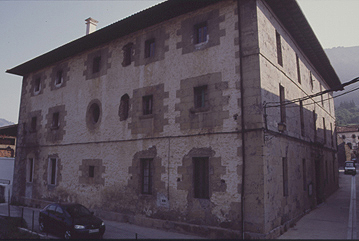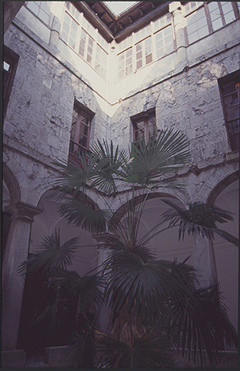The piece of the month of November 2007
INDIANOETXEA HOUSE IN BETELU
Javier Azanza López
Chair of Navarrese Heritage and Art
From the 17th century onwards, Navarre received abundant monetary remittances from those Navarrese who had been forced to seek a future far from the place where they had been born. In general, anyone who managed to increase their wealth in America, for affective reasons, turned their eyes towards their homeland, whether they returned to it or not, and this feeling was translated into the sending of money in cash and valuables; it was also a way of showing their new social position and the economic level they had reached.
In many cases and moved by their Christian piety, the Indians destined part of their wealth to religious institutions, in such a way that diverse artistic objects were sent to parishes, sanctuaries and chapels, mainly pieces of silver, jewelry and paintings, coming from the most outstanding American workshops; in others the remittance consisted of money in cash that was used in the construction or improvement of their factories, and even in the foundation of convents. Likewise, the family left behind and the solar house occupied a privileged place in the memory of the Navarrese Indians. The money sent from the Indies was destined to redeem the existing debts, basically censuses, and to increase the family patrimony by means of the purchase of real estate, farms and cattle or the imposition of the money in censuses, sometimes gathering all this under the foundation of a new entailed estate. The payment of dowries to the women of the family and the surrounding area was another of the most common purposes, and to this we must add destinations of a more spiritual nature such as mandates for the poor and charitable works, as well as the foundation of chaplaincies and anniversaries and others such as endowments of oil, wax, or even scholarships. However, one of the main investments consisted in improving the native house and even in the construction of a new building, many of them certainly relevant, which were at the head of the new links. An important architectural renovation was thus generated in Navarre, a phenomenon perfectly verified in the lands bathed by the Bidasoa, in the Baztan Valley, and also in the capital Pamplona, which should be joined by other points of Navarre average and the Ebro Valley. The construction or remodeling of the house undoubtedly became the maximum exponent of the triumph achieved in the Indies.
Almost on the border with the province of Guipúzcoa, is the town of Betelu, where there is testimony of the prosperity achieved in the Indies by Alonso de Ezcurdia, son of the marriage formed by Martín de Ezcurdia and Teresa de Recalde, owners of the Albiasurena house. We know nothing of his childhood, since one of the first news related to our character dates from the month of July 1725, when at the approximate age of 20 years he was in Cadiz ready to leave for New Spain in the fleet that was under the command of the squadron chief Antonio Serrano. The reasons for such an adventure are explained to us by Alonso himself in the letters that have been preserved in his own handwriting: he had contracted a marriage engagement with María Catalina de Orella, daughter of Juan de Orella and Magdalena Perugorri and sole heiress of the Orella palace built in Arriba, near Betelu, and he needed to improve his economic and social position to be on a par with his future political family.
We do not know what was the activity carried out by our Indiano in the city of Mexico where he settled, although very probably it had to do with the world of commerce and business, given that there is no reference letter that he occupied position military or administrative. What is certain is that his process of enrichment began shortly after arriving in the Indies, since with the fleet that left Veracruz at the beginning of June 1726 he sent 234 pesos for his mother -a widow by then- and "a very exquisite fine gold chain that in these countries they call vejuquillo" for his fiancée, to whom he assured his prompt return from the port of Veracruz to Cadiz with an important wealth that he calculated at 30,000 pesos.
This took place in 1730, as it is clear from the testimony of another Indian in Mexico, Don Martin de Iribarren, who on March 26 of that year sent to the abbot of his native town of Aldaz the amount of 12,612 pesos under the custody of Alonso de Ezcurdia, who was embarking on his return trip to Spain. And although in the end he did not marry María Catalina de Orella, there was a house that testified to his prosperity on the other side of the Atlantic.

Ezcurdia himself was in charge of the entire construction process, commissioning the layout and conditions, hiring the stonemasons in charge of its execution and supervising the development of the works until the moment of its conclusion and appraisal. The conditions for the construction of the building were signed in Betelu on March 13, 1736 by the master masons Juan Miguel de Goyeneta and Miguel de Barreneche, who were certainly not chosen at random by Alonso Ezcurdia, since they are two of the great architects of the monumental transformation of Pamplona during this period, whose intervention is also documented in numerous places in Navarre, both in religious and civil works. According to the conditions, the main façade was to be carved in good stonework, following the model of the house owned by Fermín de Huici in Villanueva de Araquil, with its main door "de Arquitectura" and its balconies and windows with the corresponding moldings; inside, the hallway would give way to an open patio from which the main staircase of the house would lead to contact the different rooms. The completion date was set for All Saints' Day 1737.
The stonemasonry work on the building was contracted by Martín de Ochotorena and the Guipuzcoan Francisco de Eceiza, who undertook to finish it by All Saints' Day 1737, except for the steps of the main staircase and the tiling of the cloister, which were to be completed by mid-February of the following year. Both masters received successive payments for their work until the moment of its completion, which was delayed until July 1738, when it was appraised by Goyeneta and Barreneche themselves, appointed by Alonso de Ezurdia and by the stonemasons respectively; the amount in which they estimated the work amounted to 37,708 reales.
The eventful life of the building, which upon the death of Alonso de Ezcurdia and his wife Juana Recalde without descendants passed through different owners and was destined for various uses that modified its original configuration, has notably deteriorated its architectural structure, in spite of the successive restorations to which it was subjected.

The house is configured as a majestic building with the main façade carved in ashlar, unlike the lateral ones, which use masonry as construction material and reserve the ashlar only for the linteled openings, some with molded parapets. In height there are three bodies with balconies and straight windows, delimited by a smooth impost in the main front, in which the entrance doorway stands out, with mixtilinear framing with lugs, flanked by recessed pilasters that serve as support to an entablature that incorporates trimmed plates; on both sides of the door there are two windows, while in the rest of the levels there are five openings, all finished off by a hipped roof with wooden eaves overhang.

The door leads to a small hallway that communicates with a square courtyard of small dimensions that maintains the triple division in height: the lower floor sample in each of its bays a double semicircular arcade slightly lowered on Tuscan columns of smooth shaft, which organize in its interior four sections covered by groin vaults whose sashes rest on a cornice with cut out plates and decorative motifs; in the noble floor of masonry there are two linteled balconies per side, while the upper one is configured as a sill articulated by columns embedded in the wall that rises to average height.
